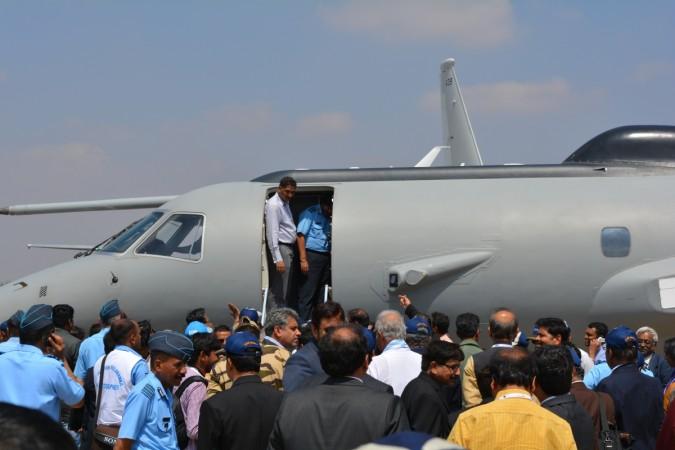
The first indigenous Airborne Early Warning and Control (AEW&C) system in Initial Operating Capability (IOC) configuration was handed over to the Indian Air Force on the first day of Aero India 2017 on Tuesday, February 14. It has positioned India in the top five countries having this capability.
A handing over ceremony was organized at Yelahanka Air Force Station in Bengaluru.
The airborne surveillance system or the 'eye in the sky' is considered to be a game-changer in air warfare.
It is populated with state-of-the art Active Electronically Scanned Radar, Secondary Surveillance Radar, Electronic and Communication Counter Measures, LoS (Line of Sight) and beyond LoS data link, voice communication system and self protection suite, built on an Emb-145 platform, having an air-to-air refueling capability to enhance surveillance time.
A complex tactical software has been developed for fusion of information from the sensors, to provide the air situation picture along with intelligence to handle classification threat assessment. Battle management functions are built in house to work as a network centric system of Integrated Air Command and Control System (IACCS) node.
This system has been developed and evaluated through collaborative efforts between Defence Research and Development Organization (DRDO) and the IAF, with coordination for certification clearance and quality assurance by Center for Military Airworthiness and Certification (CEMILAC) and Directorate General of Aeronautical Quality Assurance (DGAQA).
The requirements of defence equipment for the Indian Armed forces are met through both indigenous production and imports. Whilst considerable thrust has been accorded to indigenisation, certain equipment is imported due to non-availability of indigenous expertise, lack of vendor base and need for induction of such equipment based on threat perception.
According to the Ministry of Defence, 73 contracts involving a value of Rs72,303.34 crore were signed with Indian vendors during the last two financial years (2014-15 and 2015-16). Over 80 cases involving Rs1,60,362 crore have been accorded Acceptance of Necessity (AON) by Defence Acquisition Council under the 'Buy (Indian),' 'Buy and Make (Indian)' and 'Buy and Make' categories.
The DRDO is primarily involved in design and development of strategic, complex and security sensitive systems in the fields of armaments, missiles, unmanned aerial vehicles, radars, electronic warfare systems, sonars, combat vehicles, combat aircraft, sensors, etc., for the armed forces as per their specific Qualitative Requirements.
Some of the indigenously designed and developed weapon platforms that have been successfully inducted into the services include Advanced Light Helicopters (ALH), Light Combat Aircraft (LCA), Akash Missile Systems, Multi Barrel Rocket System – Pinaka, MBT Arjun Tanks, Sonars, etc.
Projects for defence research are undertaken by DRDO, based on the priorities of the armed forces and existing capabilities. To involve private sector in defence R&D, projects are undertaken under 'Make' category.
The Narendra Modi government has also launched Technology Development Fund (TDF) to involve industry, particularly SMEs in defence sector. According highest preference to 'Buy (Indian-IDDM-Indigenously Designed, Developed and Manufactured)' category of acquisition, and revision of 'Make' procedure in the Defence Procurement Procedure-2016 (DPP) are expected to catalyse investment into defence research, development and innovation.









!['Had denied Housefull franchise as they wanted me to wear a bikini': Tia Bajpai on turning down bold scripts [Exclusive]](https://data1.ibtimes.co.in/en/full/806605/had-denied-housefull-franchise-they-wanted-me-wear-bikini-tia-bajpai-turning-down-bold.png?w=220&h=138)



